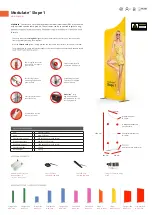
PowerFLARM Core Manual v.150 International
5
If available, PowerFLARM uses the barometric altitude from a Mode
S transponder installed on the same aircraft. If not, PowerFLARM
uses barometric altitude derived from the built-in pressure sensor.
Barometric altitude is used for determining the relative altitude to
PCAS targets.
The effective range depends very much upon the position in which
antennas are fitted and facilitates a warning, visual identification,
and appropriate action by the pilots in both aircraft.
FLARM-warnings are issued in accordance with the time remaining
to a possible collision, not the geometric distance between the air-
craft. The first warning is typically issued between 19 and 25 sec-
onds in advance to the calculated possible collision with aircraft or
obstacle (time to impact); the second is issued 14 to 18 seconds in
advance, and the third 6 to 8 seconds in advance. Warnings are
sustained as long as the threat remains as calculated. Depending
upon the prediction, the threat may be downgraded or deleted.
Warnings are selective, i.e. they are only issued if the calculation
detects a high probability of a collision in the immediate future.
PowerFLARM also warns about obstacles on the ground (cables,
masts, etc.) if the respective database is installed. Databases are
available for purchase on
Warnings are disabled if the own aircraft is considered taxiing or
stationary on the ground.
ADS-B alerts
ADS-B OUT broadcasts have originally been designed for ground-
based surveillance and collision avoidance by Air Traffic Control.
The use of ADS-B for
airborne
collision alerts is often limited by
factors such as:
•
Absence of horizontal and/or vertical speed data
•
Absence of GPS altitude data
•
Erroneous transmission of position and/or velocity data
•
Time lag in position data
Practical experience shows that airborne alerts based on ADS-B can
be useful to warn about powered traffic in cruise or relatively flat
turns such as standard procedure turns.






































